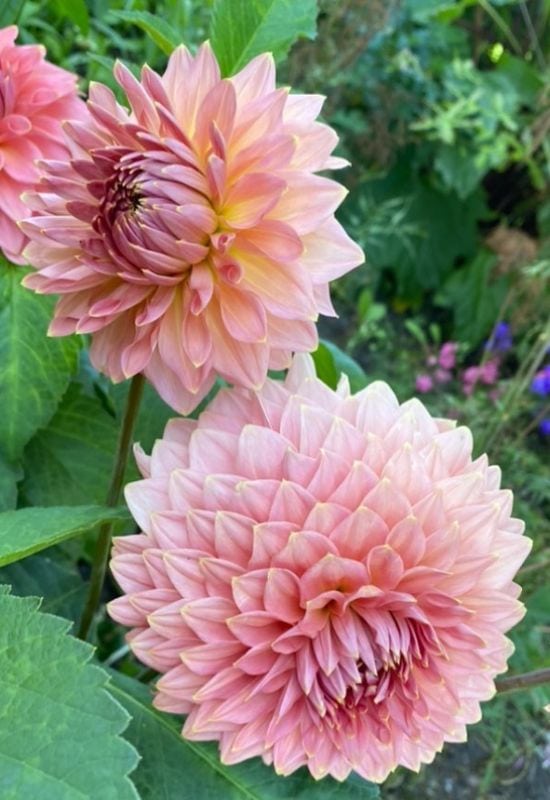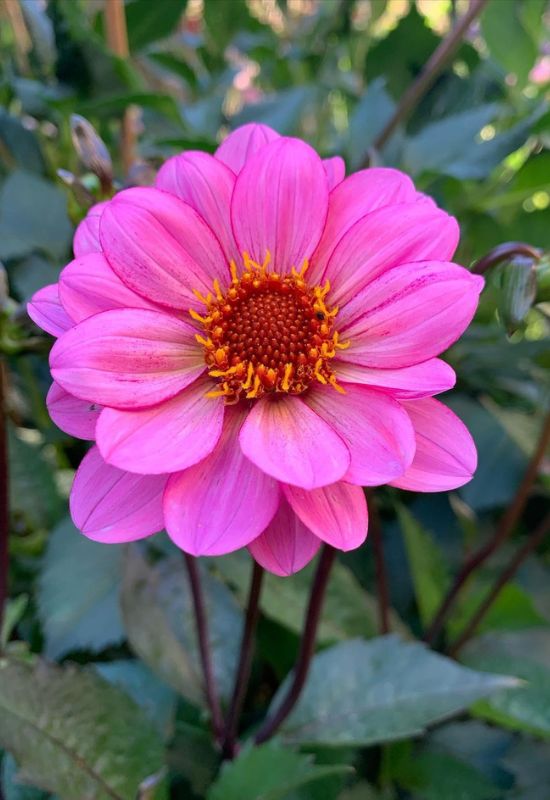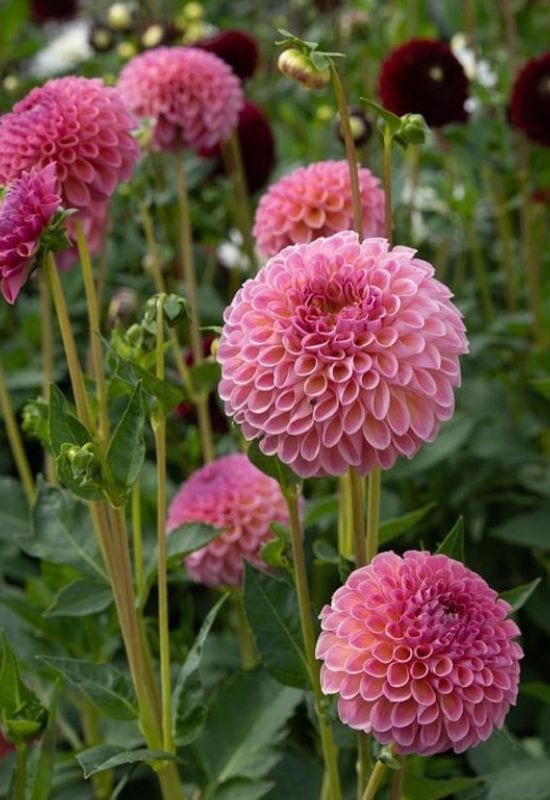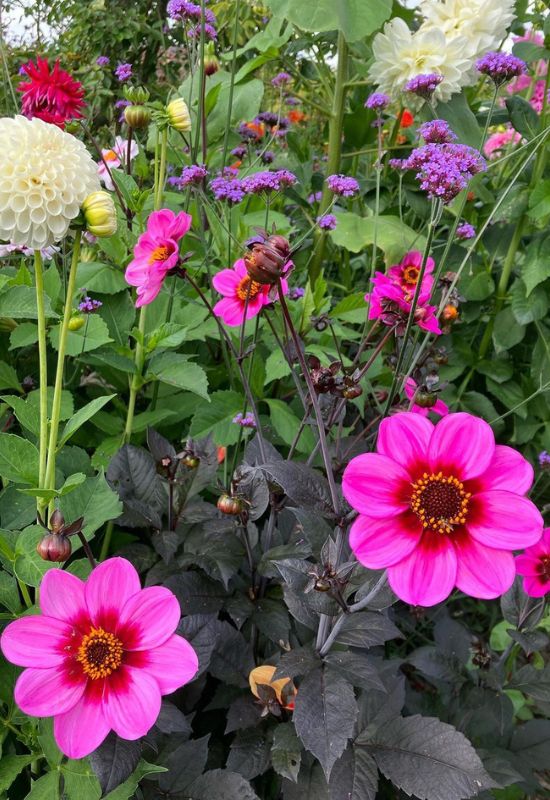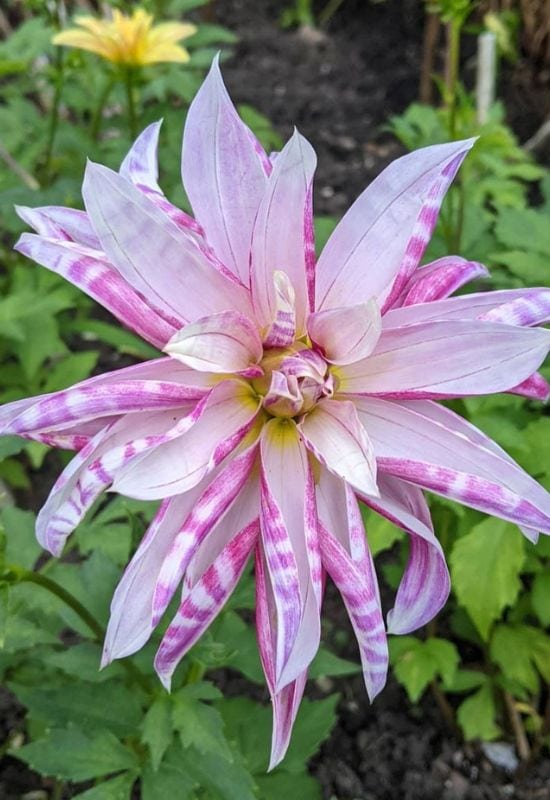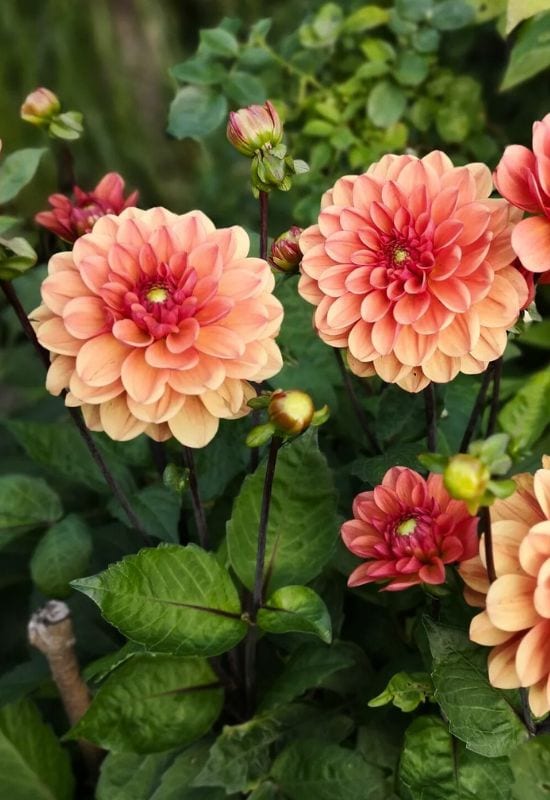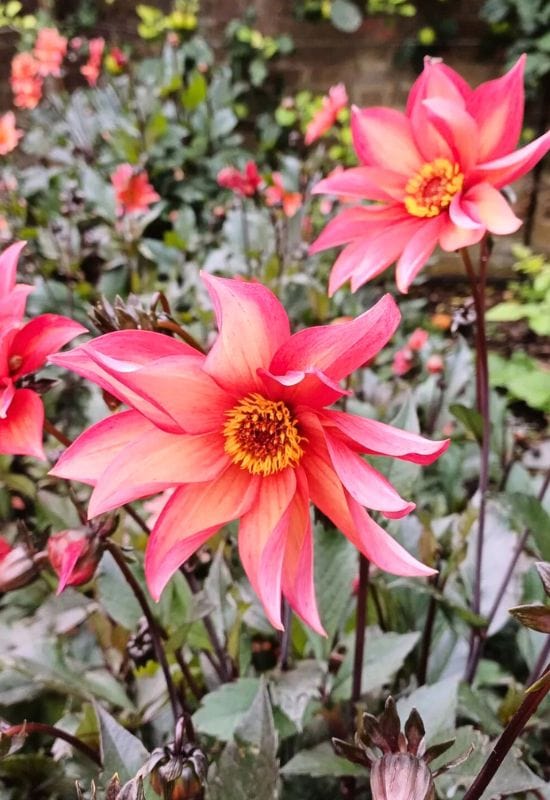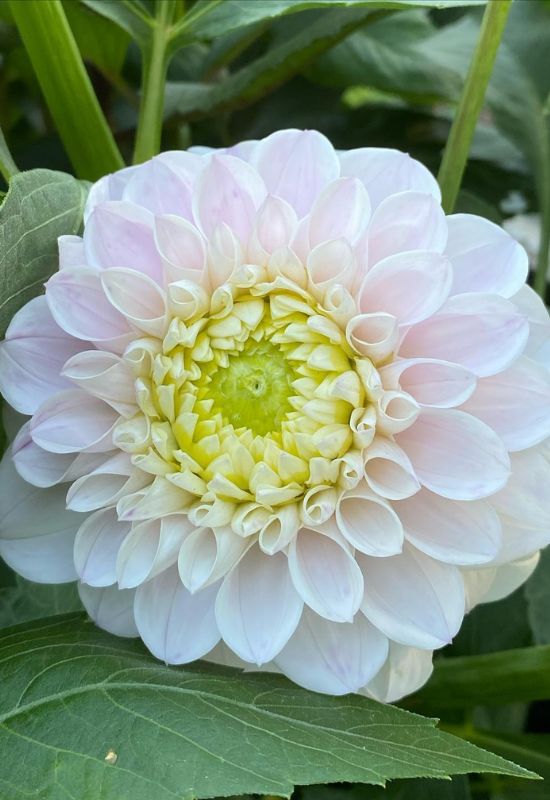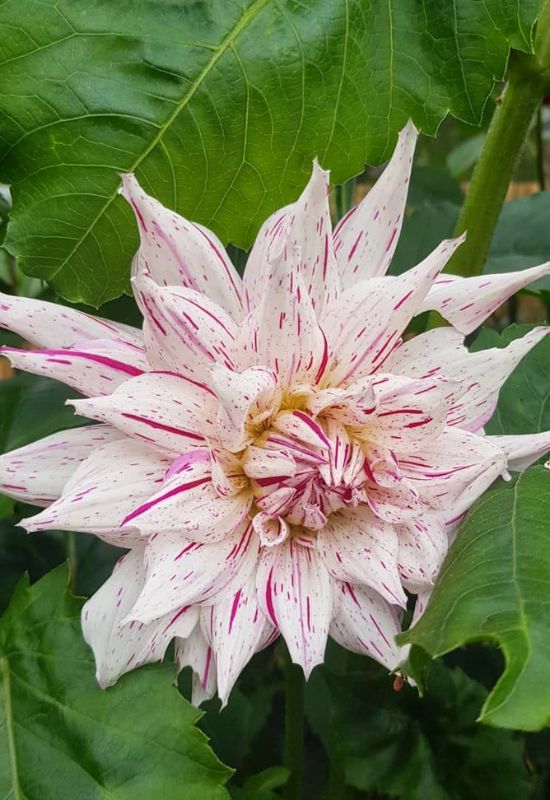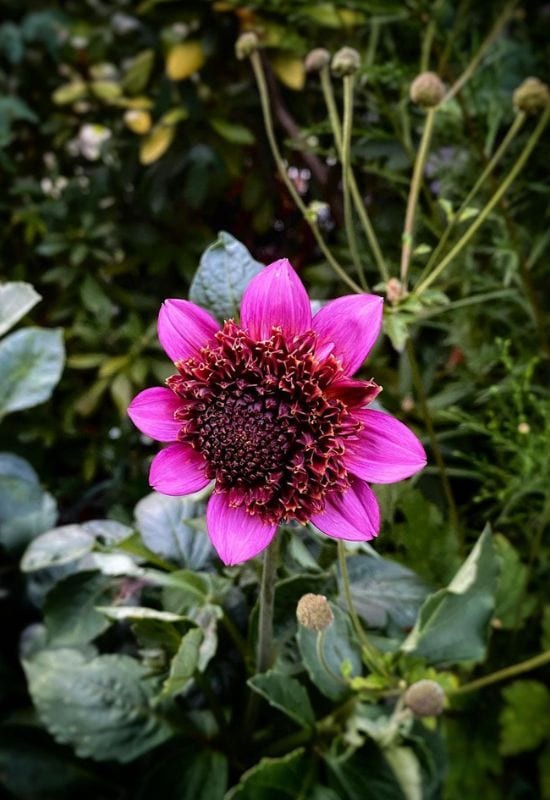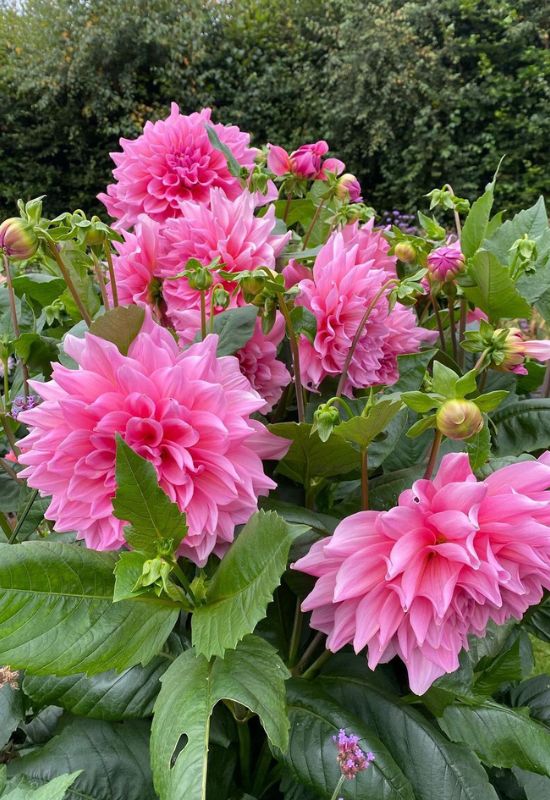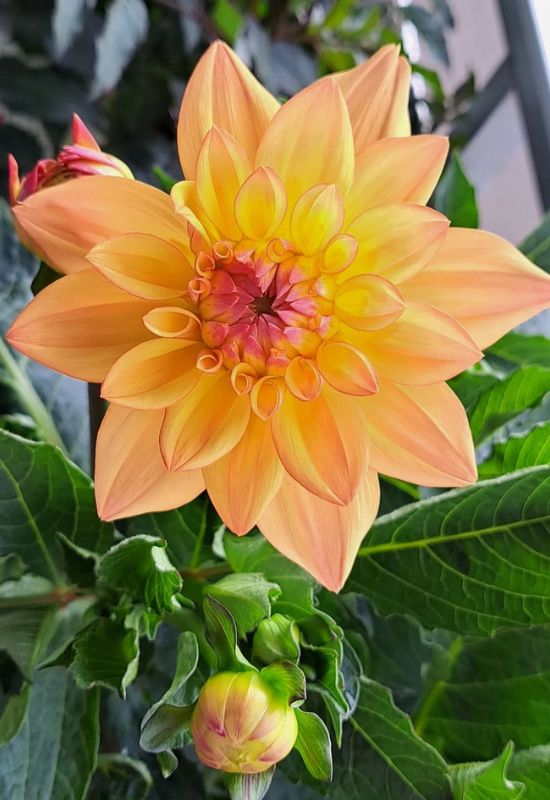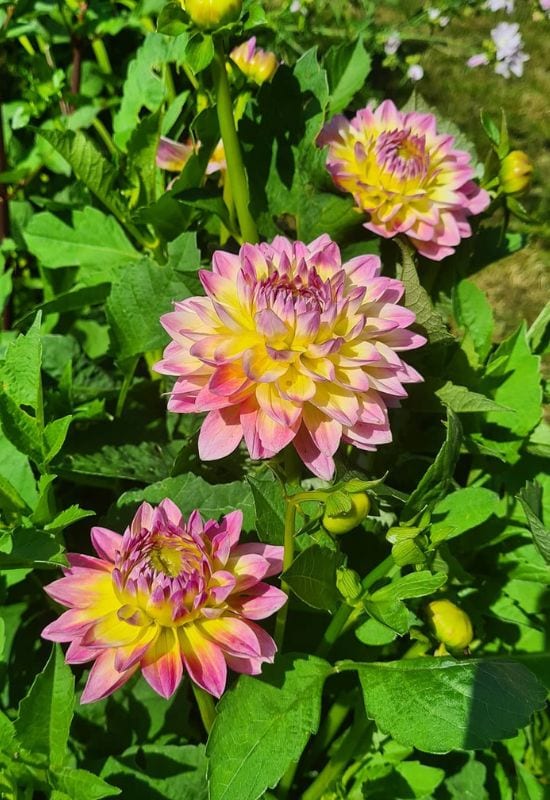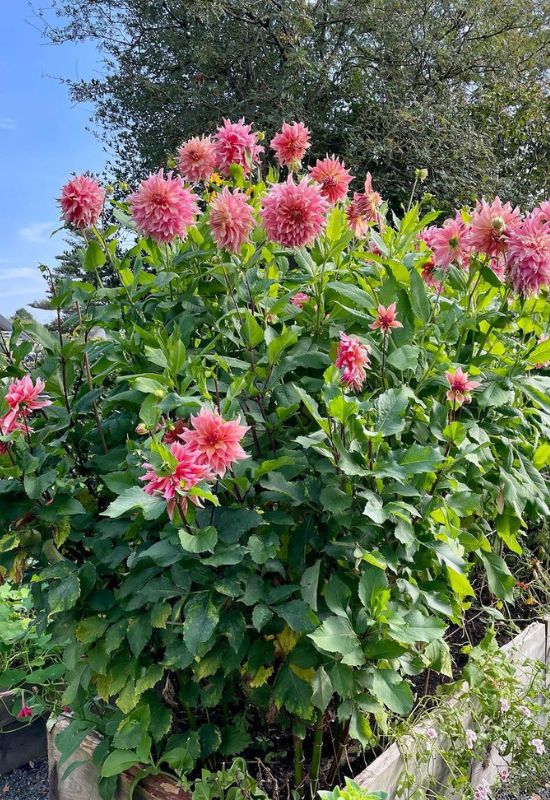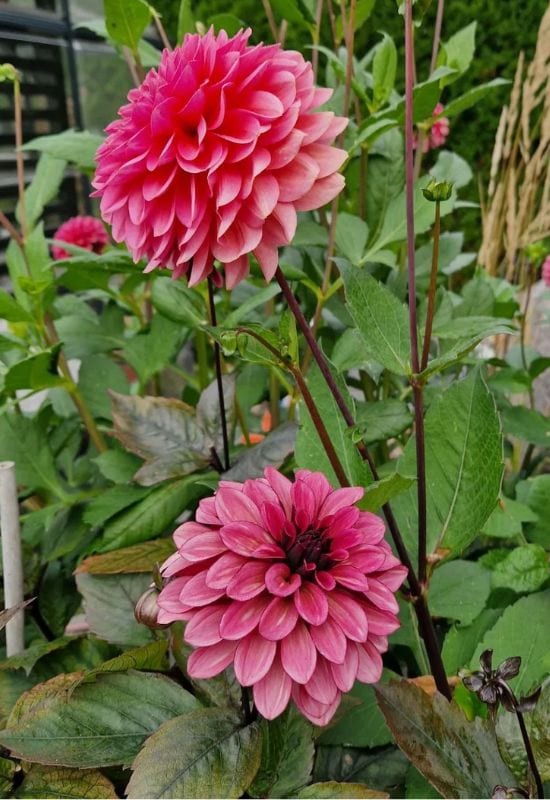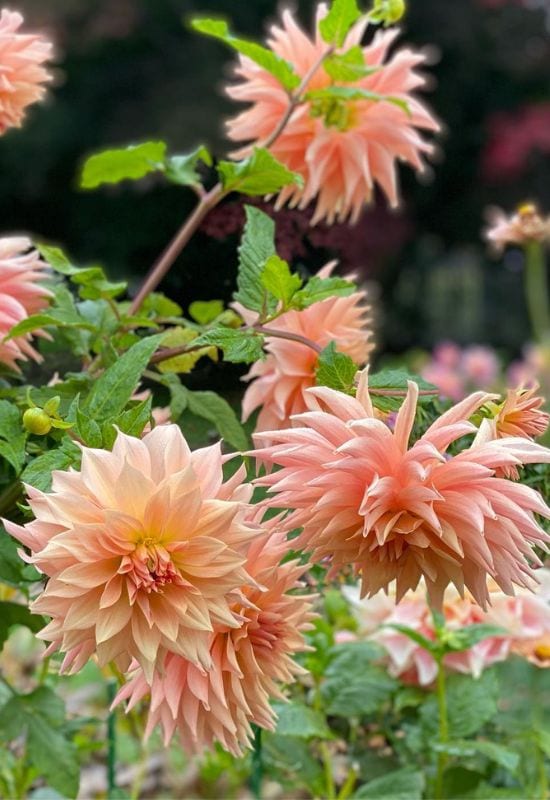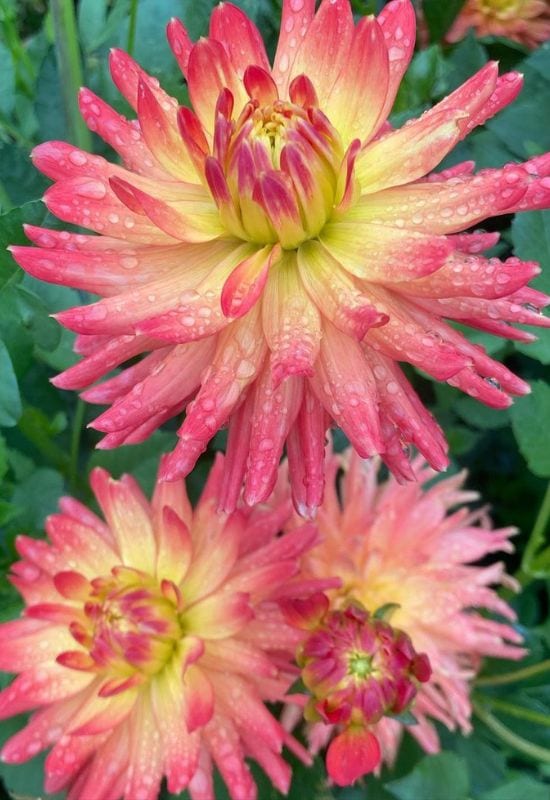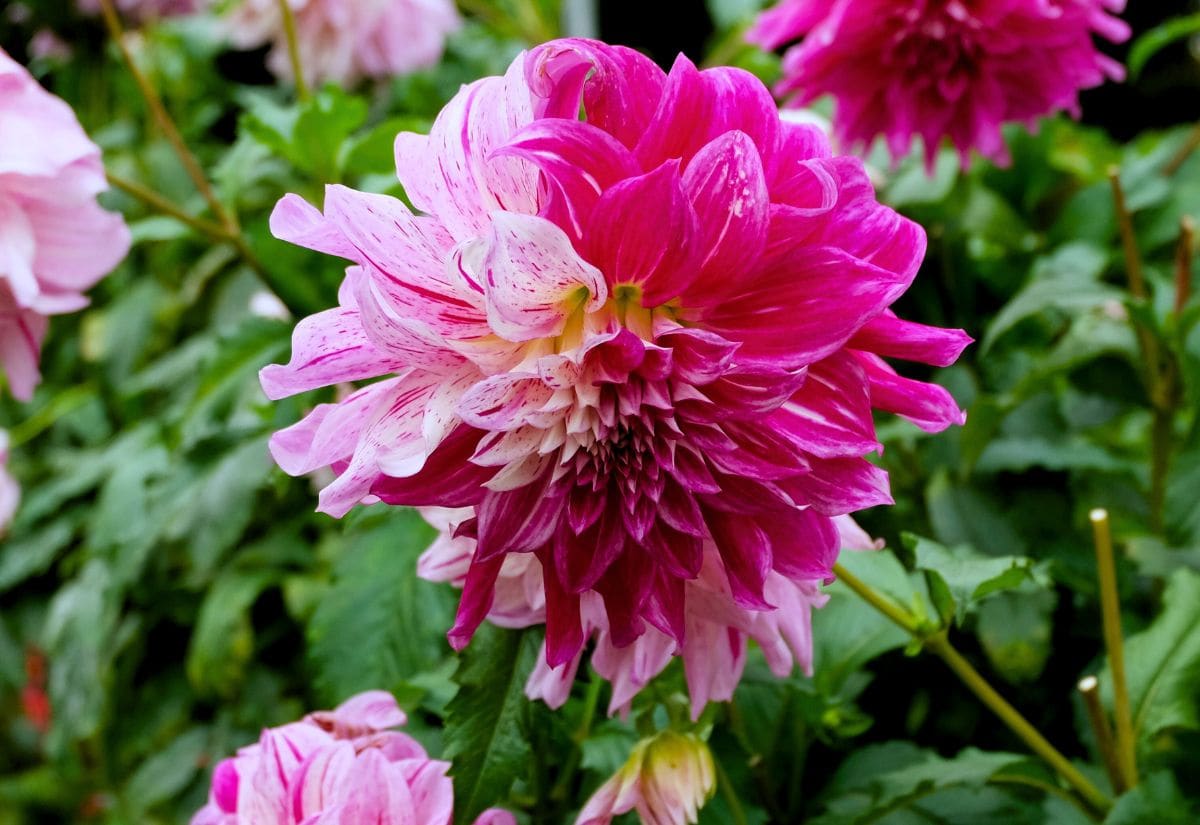
In my gardening journey, I’ve found that the most rewarding way to fill my garden with shades of pink from the beginning to the end of the season is by planting dahlias with pink flowers.
The beauty of these flowers is that their hearty blossoms endure until frost, showcasing a myriad of pink tones—soft, shell, salmon, rose, and even deep magenta.
Whether I’m aiming for a dreamy, romantic vibe or something more vibrant and striking, dahlias never disappoint, especially around my garden borders.
What fascinates me even more is that dahlias aren’t just a one-note flower. They come in a myriad of shapes and varieties – from singles to doubles, decorative to cactus, and even those resembling orchids, waterlilies, or anemones. This tuberous perennial, a worldwide garden favorite, is a blank canvas, allowing my imagination to run wild with every shape and form it comes in.
So, if you ask me for advice, I’d say never let your garden be devoid of these pink wonders. Until the very last days of fall, you can count on the generous and long lasting blooms of the most delightful pink dahlia flowers I’ve ever come across.
And if you’re anything like me, having a soft spot for shades ranging from a muted pale pink to a vivid magenta or somewhere in between, let me share with you a list of 15 pink dahlia varieties that have enchanted my garden.
Alongside, I’ll offer some personal tips on how you can use the allure of pink to take your garden designs to new heights.
24 Shades of Pink with Great Dahlias for Your Summer and Fall Garden
Here they are, adorning my garden with hues of rose, salmon, and peach, the finest dahlia varieties for pink blossoms, for your summer and fall garden!
So, ready for a journey with rose tinted spectacles? And, up first, a really decorative dahlia to grow with in a romantic border…
‘Askwith Minnie’ Decorative Dahlia (Dahlia ‘Askwith Minnie’)
Mixing romance and and design, the very popular cultivar ‘Askwith Minnie’ belongs to the decorative dahlia group, but it is also formal, less common and harder to get than informal varieties. It will strike you because it fuses row upon row of harmonic, cupped and softly pointed petals, forming a sculptural and elegant rosette, and our color.
But it also plays a lot with tonalities, starting pale, and soft at the margins, then turning pure pink, then even bubblegum and shocking, sometimes with magenta notes as your eye is charmed towards the center of the flowers!
Then again, the blossoms are fully double and quite large, from 6 to 8 inches across (15 to 20 cm), so they will be great protagonists in your garden all the way from mid summer to the very end of fall, or first day of frost!
Rising on top of sturdy stems above the lush mound of smooth edged leaves, that can be bright or very dark, this floral display will take center stage in your green haven!
Being a formal variety, ‘Askwith Dahlia’ decorative dahlia makes it suitable to a wide variety of styles, from naturalistic, like cottage or English country gardens, to exotic and even oriental designs. And having long stems, it will be a perfect pink beauty in your herbaceous borders, but also in vases indoors as a showy cut flower.
‘Classic Rosamunde’ Peony Flowered Dahlia (Dahlia ‘Classic Rosamunde’)
Did I say that dahlias like to “impersonate”, or “imitate” other flowers? So, here’s the first on my list that does it, and it belongs to the peony flowered group, ‘Classic Rosamunde’. In fact, this variety will offer you semi double blossoms all the way to the end of the season, and really loads of them, as it is one of the most generous and floriferous cultivars on the market.
Its petals are rounded and arranged in a few rows, informally and looking very natural indeed, and they display a uniform, vibrant and energetic cheery pink color! This gives our tuberous perennial a romantic but also happy, upbeat personality, and it will also attract lots of butterflies, bees and other pollinators.
Yes, because its central ring is on show as well, with its saffron stamens and a russet heart! Each blossom will range between 4 and 6 inches in diameter (10 to 15 cm) and they will all look up to the sky and the Sun! But wait, there’s an extra asset for your garden; stems and leaves are of a very dark but warm purple shade, almost tending to black!
A lovely choice for romance and drama, ‘Classic Rosamunde’ peony flowered dahlia will suit most informal herbaceous borders, but also containers, so you can enjoy it for months in end on your terrace and patio as well. Or a centerpiece on a table as a cut flower…
3: ‘Jowey Winnie’ Ball Dahlia (Dahlia ‘JoweyWinney’)
But dahlias also like to take on geometric shapes, they are the Pythagoras of perennials, and ball variety ‘JoweyWinney’ is the living proof! As you may have guessed, its blooms are round, actually spherical, but it is their exact precision that will leave you speechless, they look like an architect has designed them!
What’s more, the flowers also have a very regular arrangement of petals, that partly curl and fall, creating a regular pattern of “cells” that look like hearts, bigger at the bottom and rhythmically decreasing to small at the top.
And this adds to the romantic look of its enchanting blossoms, that are about 4 inches in diameter (10 cm). Of course, the color… It is quite uniform but it darkens at the tips, and it is pure charm pink, with a touch of carnation mixed in.
Sometimes, yellow blushes may creep in, and the long stems will bring this floral display up above the bright green foliage, which is fully in touch with the bright personality of this variety!
‘JoweyWinny’ ball dahlia is, of course, an excellent cut flower and it will suit containers and borders in informal and natural looking green spaces, where it will add romance but also an architectural touch. But it is also very geometric in shape, so you could grow it in more formal gardens.
4: ‘Henriette’ Semi Cactus Dahlia (Dahlia ‘Henriette’)
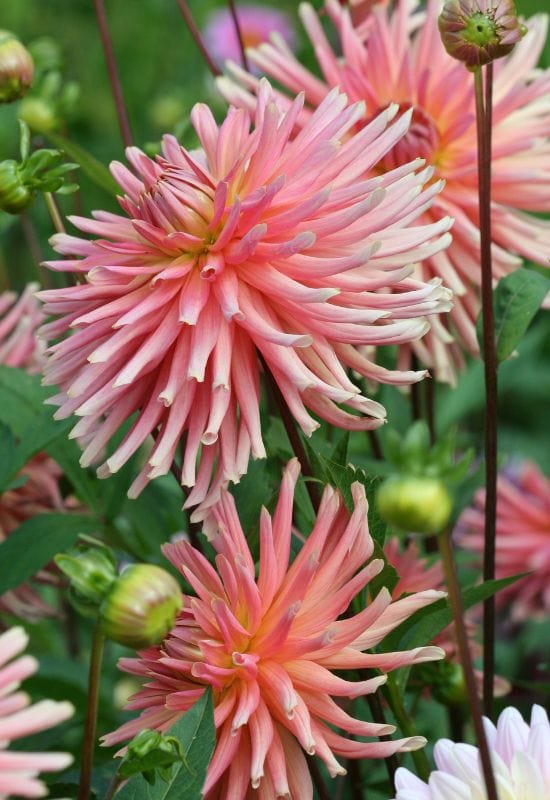
Now, pink is the color of romance, but there is romance and romance, as ‘Henriette’ tells us… In fact, this showy semi cactus variety chooses its shades with great precision to tell us a heart rending story: very soft pastel pink, but with a salmon hue as well!
But then it adds a touch of passion, of turmoil, or maybe even the sheer need to express one’s love! And how does it do it? To start with, if you look at the center of the blossoms, you will notice blushes of more intense tonalities, and even some yellow and reddish glows…
But it is the petals that give us the full effect: they are long, furled backwards and narrow, and they radiate from the middle curling gently upwards, as if praying to the sky!
Each blossom will be between 4 and 6 inches across (10 to 15 cm) and this story will last very long, page after page, blooming continuously from July to November, atop purplish upright stems and above the mid green and artistically dented foliage.
Plant ‘Henriette’ semi cactus dahlia in groups of five or more for best effect, in a herbaceous border filled with soft looking flowers, especially in shades of pink and white, and you won’t stop dreaming till frost comes late in the season!
5: ‘Happy Single Wink’ Single Dahlia (Dahlia ‘Happy Single Pink’)
I don’t know if I would define ‘Happy Single Wink’ as a shy or a cheeky dahlia… You see, this single flowered variety has lovely, really rounded petals with a little tip or dent at the end, and they spread out flat, allowing you to admire their fine, soft, almost silky texture… and they are lilac pink, quite decidedly so and with a uniform brush.
But then, at the center, they turn strong red purplish, or ruby, you could say, and this contrast is quite dynamic and showy. And then, a little crown of saffron yellow stamens gives the blossoms a noble, even royal touch, which turns luxurious with the purple eye in the very middle.
This won’t pass unnoticed by butterflies, bees, and other buzzing pollinators, who will come to your garden till late in the season, feeding and dancing on the 4 inch across blossoms (10 cm).
In fact, this floral display will be even more visible from a distance rising just a few inches above the glossy and very gently serrated to smooth super dark, almost black foliage! But this must have caught the attention of the Royal Horticultural Society, which has graced this cultivar with their famous Award of Garden Merit!
One of the best pink dahlia varieties to grow in a butterfly and natural looking garden, ‘Happy Single Wink’ will give its best if you group plant it in a sunny borders or in containers, but make sure that your landscaping style is informal, even traditional in inspiration.
6: ‘Pink Giraffe’ Double Orchid Dahlia (Dahlia ‘Pink Giraffe’)
But if you believe that pink and our tuberous perennials can only express love and romance, think again! Ok, if you saw ‘Pink Giraffe’ double orchid dahlia you may actually think you are looking at some strange and exotic species newly discovered in a rainforest… But it is actually a dahlia cultivar introduced back in 1961 by Burrows Gardens, and it has since won the prestigious Award of Garden Merit by the Royal Horticultural Society.
And deservedly so! No wonder, because its long petals have a fleshy texture, and they are long, pointed, cupped but also arching backwards, with an elegance that will leave you gasping!
And on them, well, you will see marbled stripes of ivory white and rose to fuchsia and even magenta pink. But get closer to the blossoms and you will see, nestled towards the center that rises like a fairly tale king’s crown, there, you see? Golden yellow and even lime green blushes!
That’s a really unheard of color for our genus, and of course, this luminous center makes the flowers even more showy. And they are 4 to 6 in inches across (10 to 15 cm) opening above the rich green, glossy and dense leaves on slender and upright stems.
Of course, ‘Giraffe Pink’ double orchid dahlia is one of the very best pink flowering dahlia varieties you can ever grow in an exotic looking garden, in containers, borders and even flower beds, being a small plant.
While it creates a striking visual when planted in groups, even a single specimen of ‘Pink Giraffe’ will undoubtedly be a showstopper throughout the summer season. Despite its awe-inspiring flowers, its blooming season is comparatively shorter than most other dahlias, making each blossom a cherished sight.
7: ‘Apricot Desire’ Waterlily Dahlia (Dahlia ‘Apricot Desire’)
Enter the enchanted world of ‘Apricot Desire’, a waterlily flowered variety of dahlia… And yes, this is yet another impersonation of our tuberous perennial, but one done with such exquisite delicacy that the effect is disarmingly suave.
The rows of harmonic and gently cupped oval petals open wide at the bottom and become smaller as you reach the center of the blossoms, clearly divided in layers, as you would find in a Nymphaea floating on a pond…
Large, between 4 and 16 inches in diameter (10 to 15 cm), the blooms will literally amaze you with their extremely sophisticated, soft, pale and pastel apricot pink tonality.
They look like a watercolor painting from a time long gone! Move your eyes towards the center and you will see gentle dashes of golden yellow to marigold orange, that add luminosity, while in the very middle, a small crown of strawberry pink adds a final touch of energy. All this flowery heaven blushes till the end of the season on strong stems and bright to mid, emerald leaves.
I must admit that I have a very soft spot for ‘Apricot Desire’ waterlily dahlia, in my opinion one of the most beautiful of all. And if you agree, you can have it your sunny borders or containers, in many garden styles, from traditional to oriental, or in a charming bouquet as cut flowers.
8: ‘Honka Surprise’ Orchid Dahlia (Dahlia ‘Honka Surprise’)
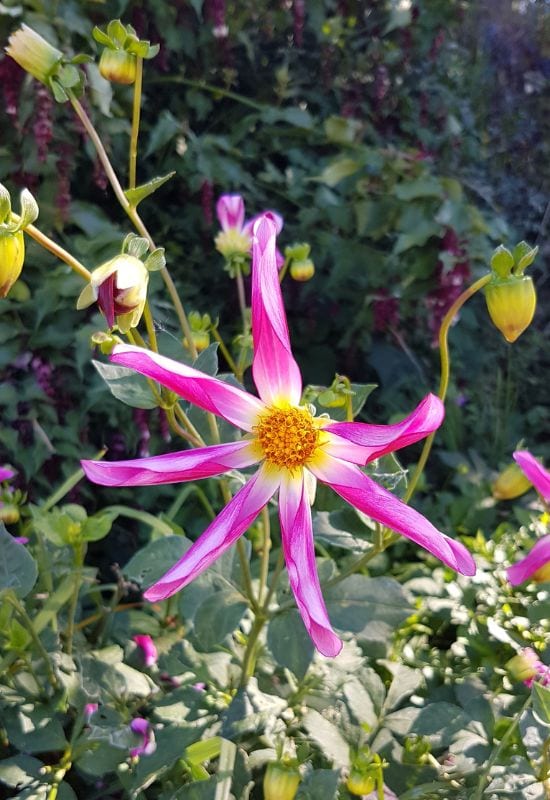
‘Honka Surprised’ is really aptly named, because you may hardly think you are looking at a dahlia variety at all! And in fact, it belongs to the orchid category, a small and rare group, and we can immediately see why… You see, it is a single flowered cultivar, with eight long petals that spread out fully, like a star, and they are narrow, but they also furl forward…
This is even more evident because the back is of a strong and vibrant magenta color, while the front has white and bright rose, fusing seamlessly and with great luminosity. And you can see both sides at the same time, but wait… The flowers that will, last until frost in your sunny garden are also slightly fragrant, which is not a common quality for our genus.
Then, you won’t miss the golden yellow and energetic center of the blooms, which seems to shine with a light of its own. Each blossom is about 4 inches in diameter, not big, but showy thanks to its color and shape.
Rising on very slender purplish stems, this exotic floral display also benefits from lush foliage as its backdrop, in bright to mid green, sometimes even taking on Castleton shades.
You will need to grow ‘Honka Surprise’ in a sheltered position in your garden if you wish to enjoy its pink flowers till late in the season. Ideal for borders and containers in informal gardens, but also offering you an exotic touch, it can be a good cut flower as well, though not one of the best among dahlias, given its slender stems.
9: ‘Jomanda’ Ball Dahlia (Dahlia ‘Jomanda’)
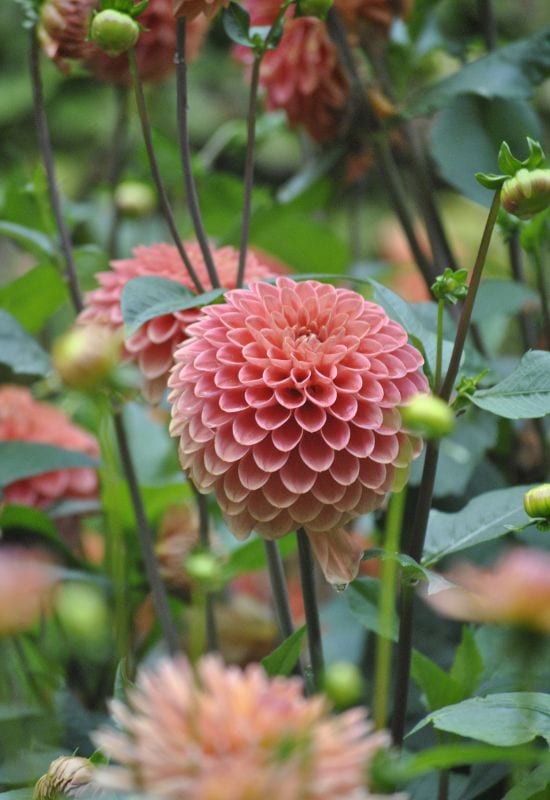
Here’s another gardening champion for you: ‘Jomanda’, a ball dahlia cultivar that has been crowned with the Award of Garden Merit by the Royal Horticultural Society! True to its category, ‘Jomanda’ boasts long-lasting blooms with a perfect spherical shape, yet there’s more to it.
The flowers, about 4 inches across (10 cm), have an incredibly artistic pattern thanks to their gently cupped petals with elegant dented or pointed tips, adding a voluminous flair reminiscent of Elizabethan ruffs, the flamboyant lace collars often depicted in paintings of Shakespeare. Now, here’s the twist:
While actually classed as a red variety, technically terracotta, but you will agree with me that the flowers are actually of a warm and deep pink shade, from salmon to strawberry in tonality, and yes, the actual shade can vary quite a lot; it is not very stable.
Nevertheless, these amazing blossoms last for months as they open continuously on long purple stems, and above a really florid and semi glossy emerald green set of leaves.
The ‘Jomanda’ ball dahlia has both depth and sculptural quality, and it has a very, very formal shape, but a heart warming color. For this reason, it can be a really valuable variety to grow in an informal herbaceous border or even in formal settings, but but in containers. And, of course, as a cut flower it is a living statue!
10: ‘Waltzing Mathilda’ Single Dahlia (Dahlia ‘Waltzing Mathilda’)
Many people may think that single flowered dahlias are “less attractive” than double ones, but it is not true, and ‘Waltzing Mathilda’ shows this really well. Then again, the Royal Horticultural Society seems to agree with me, because it has recognized its decorative value with the super coveted Award of Garden Merit…
Now, look at the elegant informal petals that taper to a distinctive pointed tips, and they sometimes wave, as if moved by the breeze, also thanks to their very thin, almost paper like texture… As the fully open blooms unfold, you’ll see pastel shades of soft pink, akin to delicate crayon strokes transitioning into blush and rose tones, as if each petal carries the whispered words, “I love you.”
But then move towards the center of the blossoms and you will also see a touch of passion, with hints of scarlet red, before you see a ring of saffron yellow stamens that encircles a purplish eye. About 4 inches across (10 cm) in size, these blossoms rise high above the very dark, deep purple and almost black serrated foliage on equally dark stems.
The contrast between ‘Waltzing Mathilda’s’ ethereal pink blossoms and its rich foliage offers a harmonious balance for gardens: romance juxtaposed with depth and drama. Beyond its aesthetic appeal, this dahlia is also a magnet for butterflies and pollinators. Whether gracing your flower beds, herbaceous borders, or even as a cut flower, it ensures a captivating display throughout the season.
11: ‘Pink Pearl’ Ball Dahlia (Dahlia ‘Pink Pearl’)
We now travel to the extreme borders of the color pink, with a stupendous ball variety of dahlia called ‘Pink Pearl’. And in fact, it has such a pale tonality of super soft pink that from a distance, you may even think it is white!
However, this very gentle blush in our color gives it a unique glow, as if the pink only came out when the flowers are kissed by sunlight. And this is why it is called “pearl”. Then again, of course, it may be due to the perfect spherical shape of the blossoms, which are medium sized, at about 4 inches in diameter (10 cm).
But there is an extra romantic touch that you can add to your garden if you grow this exquisite cultivar… The petals are pointed, larger at the bottom and smaller at the top, but they also cup and then fully furl at the back, giving you a lovely pattern of three dimensional hearts all over the flowers!
This luminous display is even brighter set against the rich but bright green, semi glossy and smooth foliage that forms the perfect backdrop.
Plant this botanical jewel, “Pink Pearl” ball dahlia, in groups of at least 5 in your herbaceous borders and you will have a luminous but also very sculptural variety with a very refined, elegant personality, which you can bring indoors as cut flowers.
12:‘Pearl of Heemestede’ Waterlily Dahlia (Dahlia ‘Pearl of Heemestede’)
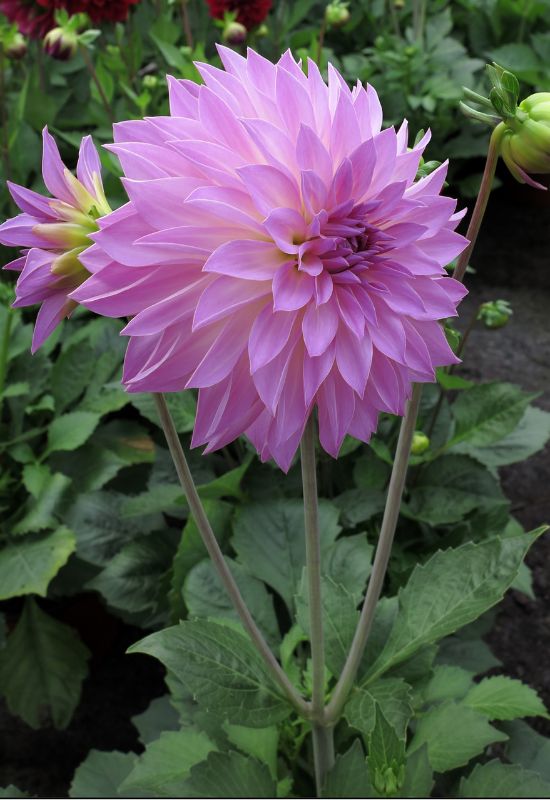
Here’s another jewel I pick for you: ‘Pearl of Heemestede’, but it is very different from the ball variety we have just met, because this dahlia belongs to the waterlily group… As you know by now, this means a really bog spectacle for your garden, but in this case, it is even bigger, because its flowers can be 6 to 8 inches across (15 to 20 cm).
The silky petals that open in clearly distinct rows are very gently cupped, elegantly tipped and almost flat, and they decrease in size as your eye moves towards the center, where you may see tiny blushes of saffron or golden yellow and bright orange. However, the predominant and enchanting hue is an exquisite shade of pure pink.
This dahlia is not just a feast for the eyes but also one of the most generous bloomers, producing loads of blossoms that open against the dark green foliage till frost. And this incredible show has gained it the prestigious Award of Garden Merit by the Royal Horticultural Society, of course…
One of the most decorative and showy pink varieties of all, ‘Pearl of Heemestede’ waterlily dahlia will definitely be a romantic but also very elegant protagonist in your borders, even stealing the show for months on end, being quite tall as well… Also suitable for oriental and exotic gardens, it will also take center stage in your living room if you grow it for cut flowers.
13: ‘Mick’s Peppermint’ Cactus Dahlia (Dahlia ‘Mick’s Peppermint’)
Cactus dahlias are famous for the dramatic and dynamic effect they create, but few reach the lyrical heights of ‘Mick’s Peppermint’! Just look at its massive blooms, which, true to its group, have double heads with twisting, pointed and backward curling petals, that seem to rebel to any order, wild and fierce as they are!
But our cultivar adds yet another energetic effect, and it does it with its palette. Most of the flower is super pale soft pink, almost whitish, but then there are rose dots or spots that emerge from underneath.
But the whole is then brought to yet another level by long and bold dashes of magenta and even scarlet! All this will keep your garden alive till the first day of frost, and with a flair for the spectacular, given the fact that the blossoms are between 8 and a whopping 10 inches in diameter (20 to 25 cm)! Rising far above the bright to mid green foliage on long stems, these flowers are really impossible to ignore!
‘Mick’s Peppermint’ is just an incredible cactus variety of dahlia for an injection of strong energy, movement and drama to an informal herbaceous border, best grown in groups, or to bring a sparking party mood to your home as a cut flower.
14: ‘The Phantom’ Anemone Flowered Dahlia (Dahlia ‘The Phantom’)
What’s so special about ‘The Phantom’ dahlia? To start with, it is an anemone flowered variety, and this gives it a particularly creative quality, thanks to the shape of the flowers of this group. But it also uses this potential at its best thanks to its amazing palette.
Let’s see… the side petals that open flat and even reflex a bit are long and fairly narrow, and they display a range of pinks that goes from soft to rose and even magenta.
But then this changes in the frilly central dome of petaloids (small petals) which are actually furled into tubular shaped that end in pointed crowns… There you will see a totally different range, with coral pink and then vibrant cherry, often hitting notes of coral red,mixing in a very contrasting explosion of shades and tonalities!
About 3 inches across (7.5 cm), the blossoms will look outward in your garden from mid summer to late fall on long stems that bring this carnival of colors above the mid to dark green foliage, which is crenated, rather than serrated.
We could safely say that ‘Phantom’ anemone flowered dahlia is arguably the most colorful pink variety of all… It will bring a really vibrant and playful spectacle to your informal borders for many months, but also eye catching cut flowers to your home.
15: ‘Otto’s Thrill’ Decorative Dahlia (Dahlia ‘Otto’s Thrill’)
We couldn’t possibly leave out the decorative variety ‘Otto’s Thrill’ from our list. In fact, it is a real champion, and the American Dahlia Society confirms that it has won more than 90 (!!!) prizes, including the most prestigious of all, the Award of Garden Merit by the Royal Horticultural Society!
And it is the perfect dinner plate cultivar in our color! It has broad petals, especially at the back, with lovely lines that run along them, and irregularly shaped, mostly flat but gently cupped as you move towards the middle.
They look like they are floating in the air, like the skirt of a ballerina in a gentle dance… The color starts of pale and soft pastel pink at the edges and it deepens to stronger and stronger tonalities as you move to the center, reaching the intensity of bright rose and even some scarlet blushes.
But then, the fully double flowers are also massive in size, ranging between 8 and 10 inches in diameter (20 to 25 cm)! The romantic blossoms rise with their “old world” beauty above the rich emerald green, serrated foliage thanks to very strong and sturdy upright stems.
Ideal for a romantic and traditional looking space, like an English country or cottage garden, ‘Otto’s Thrill’ is by far one of the most traditional looking dinnerplate or decorative dahlias you can ever grow in a herbaceous border or for jaw dropping cut flowers.
16: ‘Melody Dora’ Decorative Dahlia (Dahlia ‘Melody Dora’)
Now we meet a dahlia cultivar that expresses lots of mellow, warm and subtle feelings, but with an intensity and depth that makes it really outstanding: ‘Melody Dora’. This informal decorative variety has lovely elliptical and gently pointed petals that form elegant rosettes displaying soft and salmon pink tonalities, with rose lines that decorate the margins.
Flat to slightly cupped, they decrease in size as you move towards the center of the flower, but they also blush to shades of magenta and even crimson, especially at the tips. Yet, this is also accompanied by a golden yellow glow that adds luminosity to the whole blossom.
A perfect personality for autumnal gardens, its floral display is melancholic but also quite showy, also because the blooms are about 5 inches across (15 cm) and opening on long but fairly slender purplish stems, above serrated, semi glossy and mid green leaves.
‘Melody Dora’ is the ideal decorative dahlia to reflect the colors of the light and Sun in fall, but it will announce this season two months ahead with its romantic and sentimental personality in informal borders, flower beds or containers, and it works best if you group plant it.
17: ‘Babylon Rose’ Decorative Dahlia(Dahlia ‘Babylon Rose’)
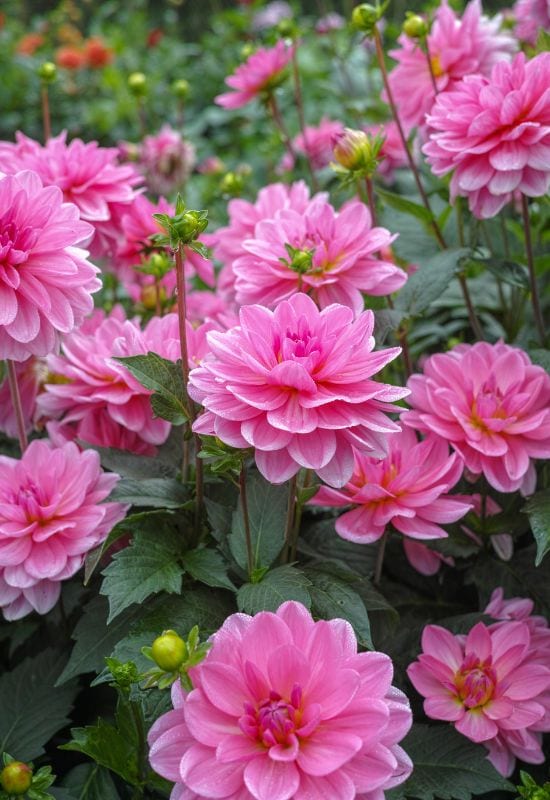
But as we said, our color has many expressions, and now we go to the vibrant, energetic end of its spectrum, with ‘Babylon Rose’, a decorative dahlia variety with a twist!
As its name will suggest to you, its blooms are of a bright, strong and luminous rose pink shade, but also very uniform and quite consistent (sometimes, the exact tonalities of our tuberous perennial may change with light and growing conditions).
And the double flowers are really large, about 8 inches across (20 cm), and with long, pointed and gently furled petals that also arch downwards and sometimes twist very, but very gently…
The effect of the upward facing blossoms of this dinnerplate cultivar in your simmer and fall garden is really showy and positive indeed, as they rise above the bright green mound of leaves underneath.
An excellent choice if you want to fill your garden with positive energy, light, and very eye catching pink blooms, ‘Babylon Rose’ has won many awards and it will suit any informal border, especially if group planted, and it provides outstanding cut flowers as well.
18: ‘Café auLait’ Decorative Dahlia (Dahlia ‘Café auLait’)
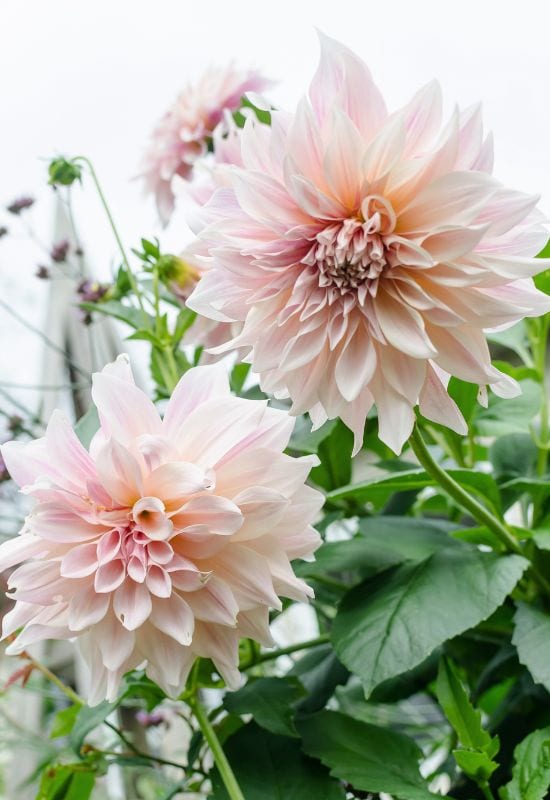
And again, we change to a totally different variety, ‘Café au Lait’, a decorative dahlia with a gentle, elegant and very romantic personality. I don’t know if its name has a reference to French Impressionist painter Edgar Degas, but surely when you see the blossoms of this cultivar his ballerinas will spring to mind… In fact, the fully double blooms have really loads of petals, which are tipped and very light, almost like silk, and they are flat at the back and cupped and furled as you get to the middle.
This gives them a three dimensional quality but also a very lace like and almost frilly one, in fact, like the little skirts you see on dancers. These flowers also come with the softest shade of peach pink on a cream backdrop, adding to the super suave and dreamy look it can offer to your garden.
But don’t be mistaken, if its colors are shy, its blossoms are actually very big indeed, 8 to 10 inches in diameter (20 to 25 cm)! All this floral display will last till the end of fall on a mound of rich emerald green and serrated foliage.
‘Café au Lait’ is a decorative dahlia that seems to cone from la belle epoque, and for this reason, it is just perfect for a herbaceous border in an old world, traditional looking space, like a cottage or English country garden. Of course, it is also ideal for a wedding bouquet…
19: ‘Jowey Gipsy’ Decorative Dahlia (Dahlia ‘Jowey Gipsy’)
And how about if you want light, and a lot of bright energy in your garden from summer to fall? Then you may need a bicolor variety like ‘Jowey Gipsy’! In fact, this formal decorative dahlia forms globular blossoms that wink at the ball group, but their petals are on full display, elliptical and pointed, like plump rosettes, and with an ivory texture.
Softly tipped and only lightly arching, cupped at the center and flat on the outside, they give the blooms shape, but they also mix amazingly cheerful colors… In the very middle, you will see an eye of strong magenta pink, and then a halo of golden yellow that brightens up the whole flower…
And then, as you move to the margins, shades of soft pink and deep rose mix and match with bold elegance. The blossoms are about 4 to 6 inches across (10 to 15 cm), and their luminosity is set off wonderfully by the backdrop of rich green, semi glossy and regularly serrated.
One of the best varieties for positive energy, ‘Jowey Gipsy’ decorative dahlia will need a sheltered but sunny location in you garden to give its best floral display. And in containers or borders, it can lift up a dull space for months in end and provide luminous cut flowers.
20: ‘Penhill Watermelon’ Decorative Dahlia(Dahlia ‘Penhill Watermelon’)
I would understand if you thought that ‘Penhill Watermelon’ is a cactus dahlia, but in fact it is not; it belongs to the decorative, or dinnerplate group. The fact is that it is so dramatic and dynamic that its energetic and massive blooms have a really wild personality.
And this is due to a match of vibrant colors and a very irregular shape. The petals are long, flat, tipped and twisting and waving, and this gives you an amazing baroque backdrop for the flowers’s powerful and creative palette.
With watermelon pink that blushes to brighter tonalities, like bubblegum and Barbie, for most of the blossoms, central stripes of deep magenta and scarlet red heat up the show, and golden glows in the central part give it an explosion of light! However, each specimen feels free to mix and match these tonalities quite freely, so it is always a surprise!
And I suggest you wear sunglasses when you look at these beauties, because they are really colossal, reaching 12 whopping inches in diameter (30 cm)! The mod green and often irregularly serrated foliage that accompanies this spectacle puts the final touch.
‘Penhill Watermelon’ decorative dahlia is by far your best choice for a bold and dramatic statement to lift up your garden with light, colors and movement till the end of the season. It will need an informal border and a sheltered location, and it can be an impressive cut flower as well.
21: ‘Star’s Favorite’ Cactus Dahlia (Dahlia ‘Star’s Favorite’)
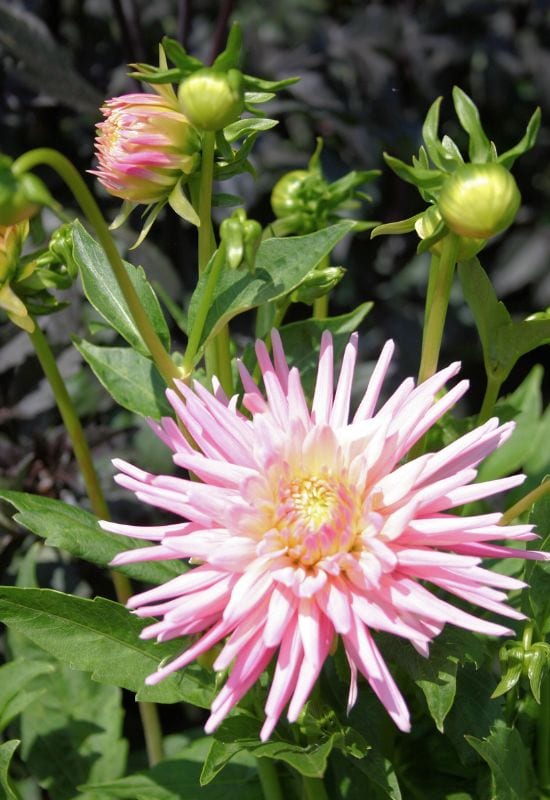
Keeping on the theme movement for your summer and fall garden, I would like you to meet a stellar cultivar, the cactus dahlia ‘Star’s Favorite’. As you would expect with this group, it has a rally unruly, wild and rebellious look… And in fact, its petals are curled into tubes, that look a bit like tentacles, and they twist and arch mainly upward…
You may think that you are faced with a sea anemone when it first blossoms, as you will be shocked by its palette of soft pink to lavender, with a hint of rose, fading to white towards the center, where you can also see a halo of lime and yellow that seems to shine from underneath…
Yes, it has really puzzling flowers indeed, and they are quite showy and large as well, ranging from 6 to 8 inches in diameter… Rising on green or purplish, upright but slender stems above the lush mid green foliage, this floral display will take your breath away!
I would see ‘Star’s Favorite’ cactus dahlia work its magic in an informal border or flower bed that needs a bit of life, a bit of energy, a bit of a twist and long lasting pink blooms. Then again, you can grow it in containers as well, or in your cutting garden.
22: ‘American Dawn’ Decorative Dahlia (Dahlia ‘American Dawn’)
But let’s move to a variety that fuses warm and delicate tonalities for your summer and fall garden: ‘American Dawn’, from the decorative group. While its blossoms are informal, the petals are quite regular, oval in shape and with a soft tip, and they open wide, arching back at the margins, while they cup very slightly as they decrease in size towards the center…
This gives the flowers a spectacular elegance, and it allows you to enjoy its refined palette it its fullest. Now, the actual coloring of the flowers can vary a bit, as often happens with cultivars that experiment with rare tonalities, however… You will see coral pink, for sure, with rosy blushes that deepen and deepen towards the middle, and often at the back of the petals, and then the blossoms blush up to range and red scarlet overtones, finally hitting deep and solid magenta for a final flush.
Each bloom can range in size between 4 and 5 inches in diameter (10 to 12.5 cm), and the floral display rises on long purple stems above a dark green set of lance shaped leaves with very fine serration.
Yet another variety with a very autumnal, melancholic but also passionate personality, ‘America Dream’ decorative dahlia will need a sheltered but sunny location in an informal border or in containers to bring your garden its exquisite palette of pink till the end of the season.
23: ‘Surprise’ Semi Cactus Dahlia (Dahlia ‘Surprise’)
It’s hard to pinpoint the exact personality of this semi cactus variety of dahlias, and, in fact, it is called ‘Surprise’… And this may be because it plays with conflicting themes, but at the sane time, it mixes them with great artistry and it achieves a final and really exquisite harmonic effect… But let’s try!
To start with, the blossoms are huge, and indeed between 8 and 10 inches in diameter (20 to 25 cm)! Fully double, these blooms follow the semi cactus structure, with partly furled and pointed, and partly twisting, or better waving petals.
But our cultivar does it with no sense of exaggeration – it has a dynamic look, but only as if floating in the breeze, rather than shaken by strong winds. Having toned down their rebellious nature, the blossoms then charm you with the softest palette ever!
Tonalities pf peach and even salmon, pastel and bight, fade to cream at the tips, but they blush to golden and saffron yellow, and luminous orange in the middle, sometimes with rosy touches, to fill the floral display with the glow of twilight, or better dawn… The bright to mid emerald green that provides the backdrop to this floral display is semi glossy, and it sets off this colorful flowery show perfectly well.
Despite the massive size of its blossoms, ‘Surprise’ semi cactus dahlia is a variety that expresses a lot of elegance and sophistication, for a romantic and dreamy garden with a naturalistic and traditional inspiration, where you can group planting in herbaceous borders, containers or for cut flowers.
24: ‘Karma Sangria’WaterlilyDahlia (Dahlia ‘Karma Sangria’)
We now come to the end of our journey in search of dahlias in the color of romance, and we have seen many changes and combinations, and the last variety on our list is ‘Karma Sangria’ a semi cactus cultivar with a really festive personality!
In fact, its flowers display a palette that’s joyous, bold, and really party like, and its shape is explosive! The long, narrow and fully furled petals end in bright rose tips with a fiery tonality, as they arch gently forward, like many horns radiating from a central point.
Looking at it, a sea urchin or porcupine may come to mind, or a three dimensional star, with an uplifting and sculptural nature… Then, moving towards the central parts of the blossoms, which look up to the Sun and the sky, you will see it fade to gentler pink shades, like French, knockout and bubblegum, and finally taffy.
But this is only before you meet a sudden burst of light at the very core with brilliant yellow hues, that can include canary, lime, or warmer notes in golden and even saffron! It looks like there is a light shining at the heart of these floral beauties, and each bloom can be about 6 inches in diameter (or 15 cm).
Opening on top of long and straight, but also sturdy purple stems that withstand rainy days, this floral display stands out really powerfully against the backdrop of very dark and deeply dented leaves! And last, but not least, it has won a lot of prizes, including the biggest of them all – the Award of Garden Merit by the Royal Horticultural Society!
Outstanding as a cut flower, ‘Karma Sangria’ semi cactus dahlia will literally shine in your herbaceous border or in containers, with its exuberant personality and long lasting flowers that can energize your garden from the peak of the season all the way till the first day of frost!
Pink and Rose Dahlia Varieties: A World of Colors and Shapes for Your Garden Ideas!
Dahlias are famous for their warm colors, but I think their real best is in the pink spectrum. I find that they have such a wide range of tonalities, shades, but also shapes and combinations that I actually had to force myself to stop this article, because with cactus, waterlily, peony, dinnerplate and so many other groups, the list could go on and on – and on…

Written By
Adriano Bulla
After many years as an academic in London, Adriano Bulla became a writer, publishing books like A History of Gardening, Organic Gardening and Elements of Garden Design; he then decided to become a gardener, following his childhood dream, and has been following his dream writing and gardening professionally in Southern Europe, where he has specialized in new and innovative organic gardening fields and techniques, like permaculture, regenerative agriculture, food forests and hydroponics.

